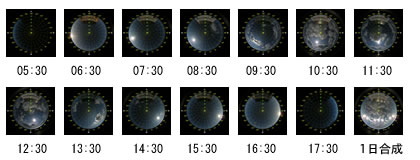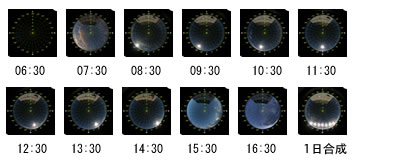HOME|Ideas and resoueces for planetary science experiments|Daily motion of the sun --- Part1
宇宙の実験教室
Ideas and resoueces for planetary science experiments
カテゴリ
Category
- 実験教室Idea and Resources for Space science experiments
- 対象項目別Category: Contents
- 学年単元別Category: Study Age
-
- 実践授業Activity Reports
タグ
Tag
 太陽の日周運動 その1
太陽の日周運動 その1
ねらい
季節によって太陽の日周運動の見え方が変わることを理解しよう。
地球の自転によって太陽はどのように動いて見えるでしょうか。 180度視野のレンズを装着したデジタルカメラ(全天カメラ)で撮影した太陽の1日の動きの映像を見て、ワークシートや透明半球に太陽の動く道すじをプロットし、どんな道すじになるのか確かめてみましょう。
この太陽の道すじは一年中同じでしょうか。 季節によって太陽の出ている昼の長さと夜の長さは違いますね。これは太陽の動く道すじが季節によって違うからです。全天カメラの太陽の映像は、同じ場所で季節ごとに撮影したものを見ることができます。各季節についても同様に、映像から太陽の動きをワークシートや透明半球にプロットし、一年を通じて太陽の道すじがどのように変化するのかを調べてみましょう。そして、調べた結果から季節による昼と夜の長さの違いを考えてみましょう。
太陽の動きを思い出せ!
太陽ののぼらない日はありません。いつもそこにある太陽ですが、どこからのぼって来ているか、どこへ沈んでいくのか、空のどこを通っているのか、わかりますか。ちょっと思い出してみましょう。
太陽ののぼる時間、それは明るくなる時間です。明るくなる時間はいつも同じですか?暗くなる時間についてはどうでしょう?季節による太陽の動きの違いについても考えてみましょう。
全天カメラとは
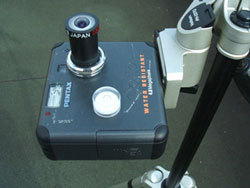 |
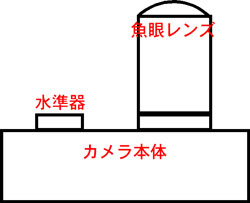 |
全天カメラ全体像 |
横から見た模式図 |
全天カメラシステムは、撮像カメラ(デジタルカメラ)・魚眼レンズ・水準器から構成されています。
魚眼レンズは視野が180度あるので、魚眼レンズを付けたカメラを天頂に向けて撮影すると、カメラを設置した場所から見た空全体の風景をひとつの写真に撮ることができます。
魚眼レンズの見え方
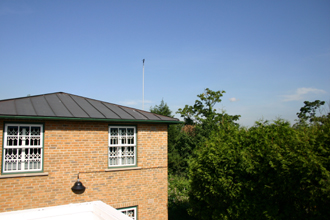 |
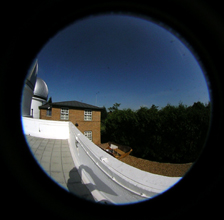 |
普通のレンズで撮った写真 |
同じ場所で魚眼レンズで撮った写真 |
ムービーはどうやって作るの?
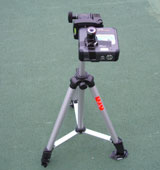 全天カメラシステムを使って、日の出から日没まで一定時間ごとに空全体の写真を撮ります。こうして撮影した画像データをパソコンに取り込み、Adobe社のグラフィックソフトのイラストレーターを使って方角や画像の調整、方位・高度座標の挿入をします。さらに、Microsoft社の動画編集用ソフトMovie Makerを用いて、各画像を時間の経過と共に編集し映像化します。
全天カメラシステムを使って、日の出から日没まで一定時間ごとに空全体の写真を撮ります。こうして撮影した画像データをパソコンに取り込み、Adobe社のグラフィックソフトのイラストレーターを使って方角や画像の調整、方位・高度座標の挿入をします。さらに、Microsoft社の動画編集用ソフトMovie Makerを用いて、各画像を時間の経過と共に編集し映像化します。
実験方法
用意するもの
日周運動のムービー、2時間おきの映像、ワークシート(これらのファイルはダウンロードできます)、パソコン、映像を見るためのアプリケーション
ムービーを見よう
ムービーを見て、太陽がどちらからどちらへ動いているか、大まかな道すじを確認しましょう。
2時間おきの太陽の位置を記録しよう
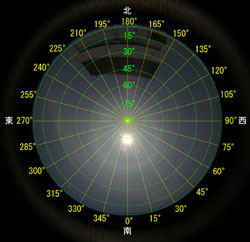

次に、2時間おきの映像を見て太陽の位置を読みとり、ワークシート上にプロットしましょう。
左の写真は仙台市(宮教大屋上北緯38度)で2005年6月21日の日周運動ムービーの午前11時43分(南中時)における映像です。淡く白い円形が太陽です。この映像から、方位・高度を読みとってワークシートに記入したものが右の図です。
同様にして、2時間おきの映像を見て、ワークシートに太陽の1日の道すじを記録しましょう。
別の季節の太陽の道すじも記録しよう
別の季節に撮影された映像を見て、季節による違いがあるかを確認してみましょう。
同じように、2時間おきの映像から太陽の位置を読みとり、ワークシートに太陽の1日の道すじを記録しましょう。
観察結果
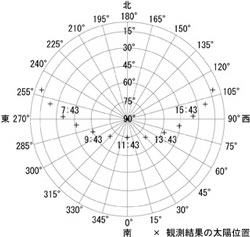
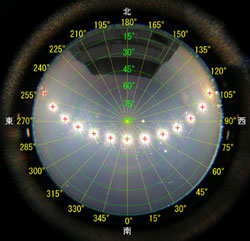
仙台市(宮教大屋上北緯38度)で撮影された2005年6月21日の日周運動の映像を見て、1日の太陽の動いた道すじをワークシートに記入したものです。
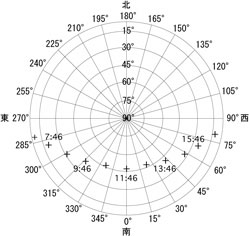
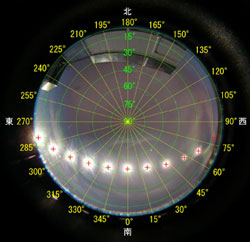
仙台市(宮教大屋上北緯38度)で撮影された2005年3月15日の日周運動の映像を見て、1日の太陽の動いた道すじをワークシートに記入したものです。
比べてみよう
記録した太陽の道すじを6月と3月とで比べてみましょう。 南中高度、日の出の位置、日の入りの位置、昼の長さなど、どのようにちがいますか。
観察のまとめ
観察してわかったことをまとめましょう。
- 太陽は東からのぼり、南の空を通って、西に沈んでいくように見える。
- 6月の南中高度は3月より高い。
- 6月の日の出と日の入りの位置は3月より北よりになる。
- 6月の昼の長さは3月より長い。
考えよう
このように、季節によって太陽の南中高度や昼の長さにちがいが生じるのはどうしてでしょうか。
宇宙から見た地球と太陽の位置関係から天球上の太陽の動きを考え、その理由を探ってみましょう。
考えよう
※観察結果の「考えよう」へのリンクとなっています。
天球で確かめよう(1)
地球は太陽のまわりを図のように1年かけて回っています。これを公転といいます。
図の(a)~(d)の位置にあるときの太陽の見え方を、天球を使って確かめましょう。
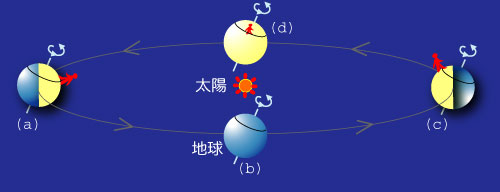
位置(a)から考えてみましょう。
星の動きを考えたときに、地球からいろいろな距離にある星を大きな球の表面に貼り付けて、想像上の球形の天井「天球(てんきゅう)」を作りました。天球についての復習はこちら
太陽も、星のひとつですから、天球上に貼り付けることができますね。下の図は位置(a)の太陽と地球の図です。地球が太陽のまわりを回っている面(=公転面)と地球の自転している方向とは約23.4度かたむいています。したがって、このときの太陽は地軸から約66.6度の方向にあり、次の図のように、天球上に描くことができます。
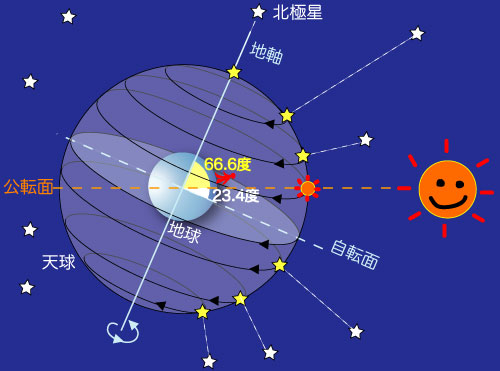
次に、地球を天球の中心に小さく縮めて、観察者に地面を作ってあげて、太陽の道すじを描いてみましょう。すると、下の図のようになりますね。
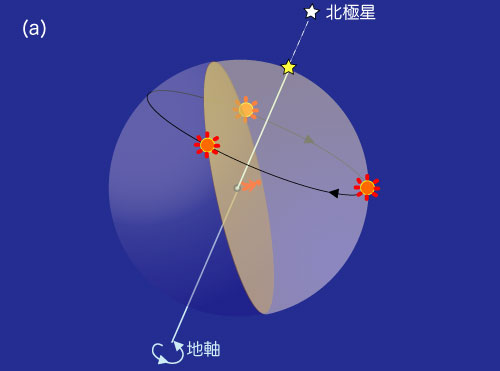
北極星のある方向が北であること、太陽の昇ってくる方向が東であることを考えて、東西南北の方向を書き入れてみましょう。
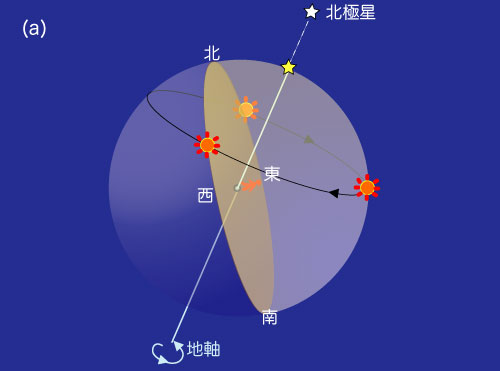
(b)の位置についても考えてみましょう。(b)では画面の裏側が昼なので、観察者も裏側に行ってしまってこちらからは見えませんね。ですから、観察者の立っている地面の方から見ている絵になります。太陽が昇っていく方向が東なので図のように東西南北の方向が書き入れられますね。
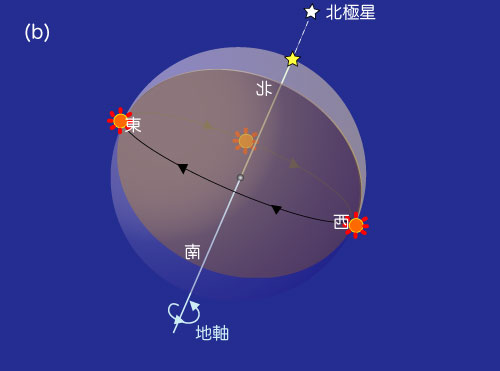
同様にして、地球が(c)の位置、(d)の位置にあるときの太陽の道すじを考えてみましょう。
地球が(c)の位置にあるときの太陽の道すじです。
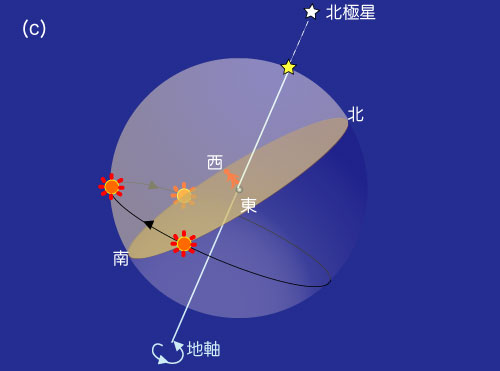
地球が(d)の位置にあるときの太陽の道すじです。
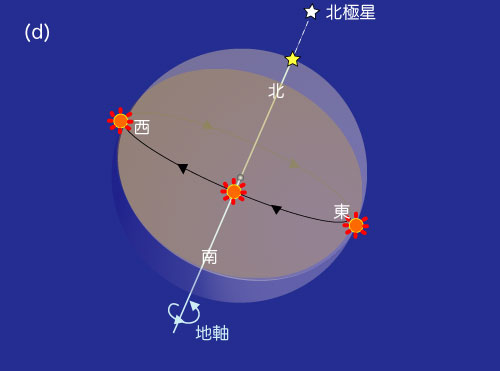
天球で確かめよう(2)
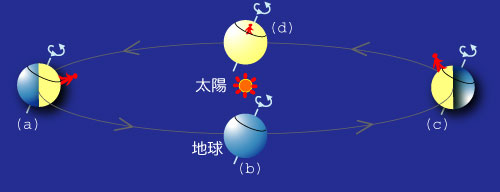 |
|
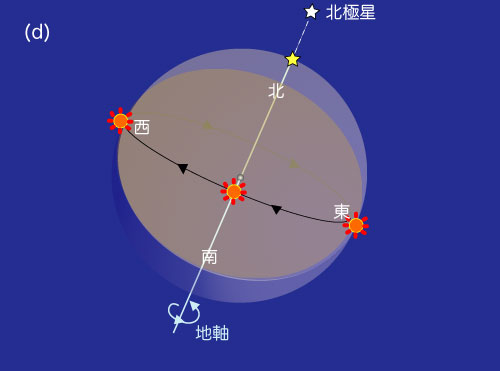 |
|
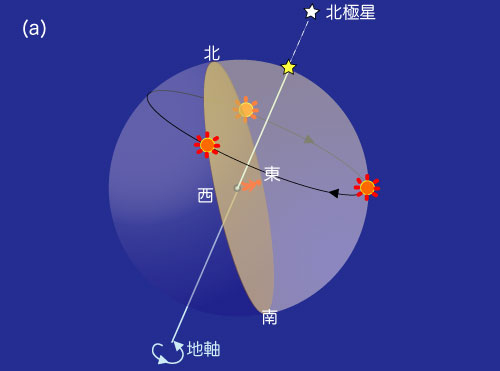 |
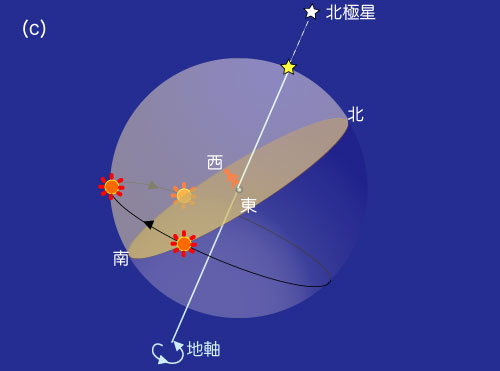 |
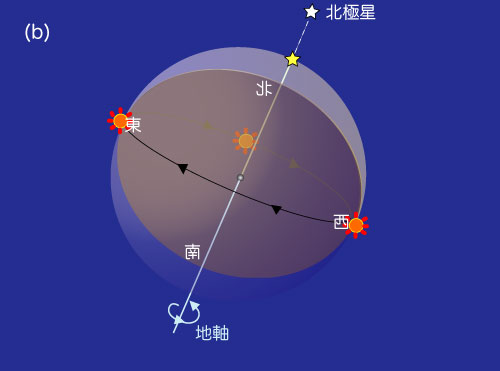 |
|
ここで、上の図で考えた太陽の道すじを、観察者の立っている地面を水平にして考えた天球に描いてみましょう。東西南北に注意してください。
すると、次のようになりますね。
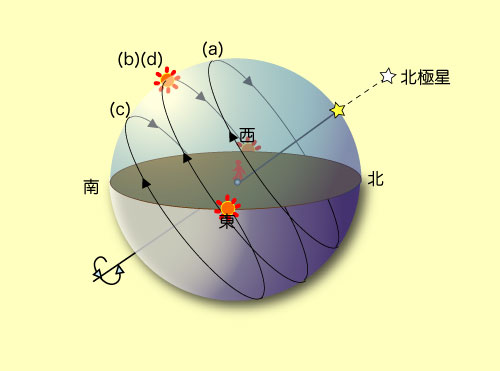
天球で確かめよう(3)
では、(a)(b)(c)(d)それぞれの位置にある時の北半球の季節は何になるのか、考えてみましょう。
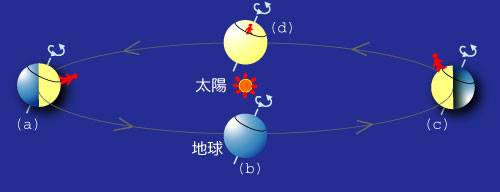
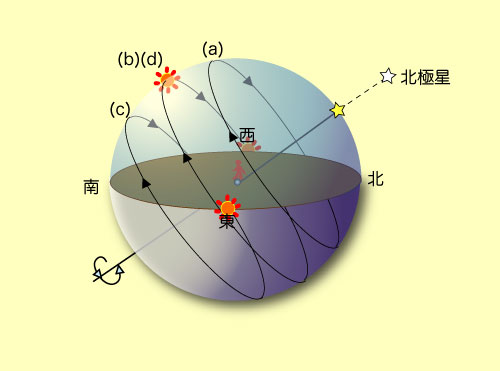
(a)(b)(c)(d)それぞれの位置にある時の、昼と夜の長さ、南中高度を比べて、それぞれ北半球が春夏秋冬のどの季節にあたるか、をまとめてみると、下の表のようになりました。
| 太陽に対する地球の位置 | 昼と夜の長さ | 南中高度 | 北半球の季節 |
| (a) | 昼の方が長い | 最も高い | 夏 |
| (b)(d) | 昼と夜の長さが同じ | 中くらい | 秋・春 |
| (c) | 夜の方が長い | 最も低い | 冬 |
天球で確かめよう(4)
地軸がかたむいていなかったとしたら、天球上の太陽の道すじはどうなるでしょうか。 地軸がかたむいていないので、地球の公転の様子と(a)(b)(c)(d)それぞれの位置にあるときの天球上の太陽の道すじは下の図のようになりますね。
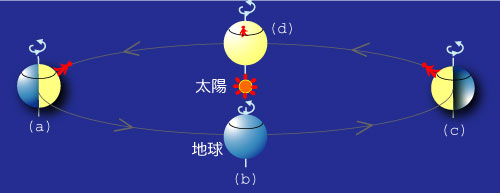 |
|
 |
|
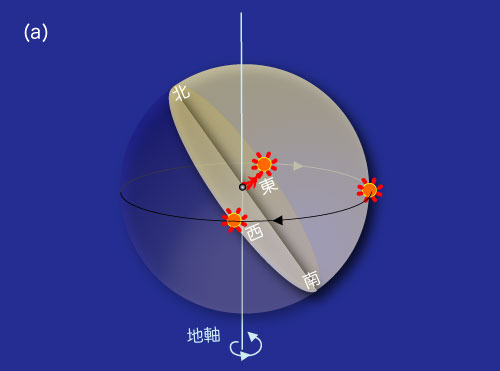 |
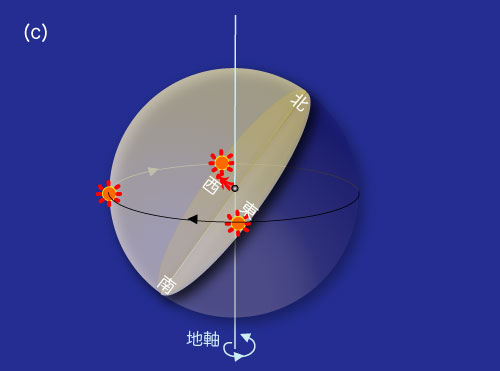 |
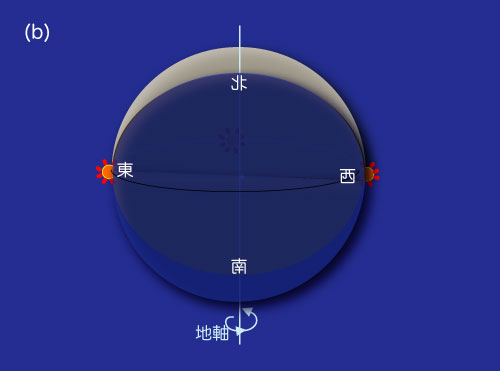 |
|
ここで、上の図で考えた太陽の道すじを、観察者の立っている地面を水平にして考えた天球に描いてみましょう。東西南北に注意してください。 すると、次のようになりますね。
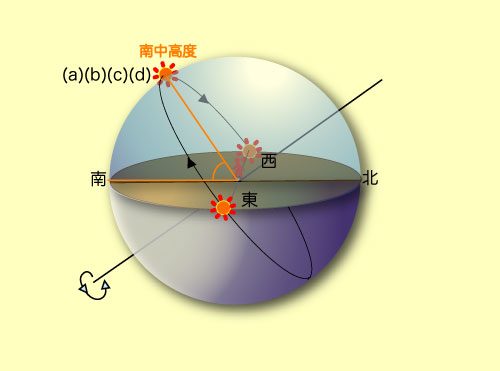
地軸がかたむいているときは、地球が(a)の位置にあるときと、(b)(d)、(c)の位置にあるときとでは、それぞれ太陽の道すじがちがいましたが、地軸がかたむいていないと考えると、地球がどの位置にあっても太陽の道すじは同じで、南中高度や昼夜の長さに違いが無くなってしまいます。
このように、地球の地軸が一定の角度でかたむいたまま太陽のまわりを公転していることは、季節が生じる大きな原因となっています。
発展
天王星は、地軸が公転面と約90度かたむいています。したがって、太陽がずっと出ているときや全く出ないときがあり、とても極端です。 太陽と(a)(b)(c)(d)のどの位置にあるとき、太陽がずっと出ている、あるいは全く出ないのか、考えてみましょう。
ダウンロード
 Daily motion of the sun --- Part1
Daily motion of the sun --- Part1
Introduction
Path of the daily motion of the sun changes with seasons.
How does the Sun move due to the earth's rotation?
Check out the path of the sun. Watch the movie of daily motion of the sun that was taken with a digital camera with a 180-degree field of vision lens and plot the path on a worksheet or a clear plastic hemisphere.
Is the path the same all year long?
Length of day and night changes with seasons. This is because the path of the sun changes with seasons.Watch the movies which are taken by the whole sky camera in the same place in each season. Plot the motion of the sun on a worksheet or a clear plastic hemisphere from the movie of each season and ceck out how the path changes over the year. Think of the difference in length of day and night in different seasons from the results.
The sun rises everyday. It is always there, but do you knonw where it rises, reaches its highest point in the sky, and sets?
The time the sun rises is the morning. Does the morning begin at same time? How about the evening? Think of the daily motion of the sun in each season.
Imagine the motion of the sun!
The Whole Sky Camera system is composed of the digital camera, the fisheye lens, and the a level.
Because the fish-eye lens has 180-degree field of view, Whole sky scenery from the place where the camera was set up can be taken in one photograph by turning the camera with the fish-eye lens to the zenith.
The whole sky camera
 |
 |
Over view image of the Whole Sky Camera |
Pattern diagram seen from side |
The Whole Sky Camera system is composed of the digital camera, the fisheye lens, and the a level.
Because the fish-eye lens has 180-degree field of view, Whole sky scenery from the place where the camera was set up can be taken in one photograph by turning the camera with the fish-eye lens to the zenith.
The view through the fisheye lens
 |
 |
A picture taken by normal lens |
A picture taken by fisheye lens at the same place |
How are the movies made?
 From sunrise to sunset, a whole sky photograph is taken at regular intervals by the Whole Sky Camera system. This image data is downloaded onto a computer, the directions and the images are processed, and coordinates of direction and altitude are added to them using Adobe graphic soft Illustrator. Moreover, each image is edited with the passage of time to make movies by using the software Movie Maker to edit Microsoft-based animations.
From sunrise to sunset, a whole sky photograph is taken at regular intervals by the Whole Sky Camera system. This image data is downloaded onto a computer, the directions and the images are processed, and coordinates of direction and altitude are added to them using Adobe graphic soft Illustrator. Moreover, each image is edited with the passage of time to make movies by using the software Movie Maker to edit Microsoft-based animations.
Experimental Method
Things to prepare
The movies of daily motion of the sun, taken at two hour intervals, Worksheet ( You can download them.), PC, Application for seeing movies
※If you have any chance to make a movie of daily motion of the sun at school that contains landscape with which you are familiar, that is the best one.
If you want to make a movie by yourself, go to Making movies by The Whole Sky Camera
Let's watch the movie!
Watch the movie and check out the path of the sun. From where to where is it moving?
Record the position of the sun at two hour intervals.


Next, watch the movie, note the position of the sun at each two hour interval and plot it on your worksheet.
The left is one of the images in the movie of daily motion of the sun taken at 11:43 a.m. (Culmination) on June 21, 2005 at Sendai Japan (latitude 38 degrees north).A light white circle is the sun. The right diagram is the worksheet with the position of the sun plotted by reading the direction and the altitude of it from the left image.
In the same way, record the path of the sun over a whole day in your worksheet by watching the image every two hours.
Record the path of the sun in other seasons.
Watch another movie taken in the other season and find out if there are any differences between the seasons.
In the same way, read the position of the sun from the images every two hours and record the path of the sun during a day.
Discussion


The pictures above are plotted by the movie taken on June 21, 2005 at Sendai Japan (Latitude 38 degrees north). They show the path of the sun during a day.


The pictures above are plotted by the movie taken on March 15, 2005 at Sendai Japan (Latitude 38 degrees north). They show the path of the sun during a day.
Let's Compare them.
Compare the paths of the sun that recorded in June and March.
Can you find out the differences between them in Culmination altitude, position of sunrise, position of sunset and length of daytime? How different are they?
Practical Description
Describe what you understood from the observation.
The sun rises in the east and sets in the west reaching its highest point in the south.
The culmination altitude in June is higher than March.
The position of sunrise and sunset in June becomes more northern than March.
Daytime in June is longer than March.
Discussion
Why do the culmination altitude or length of day change with seasons?
To find out the answer, imagine the motion of the sun in the Celestial Sphere that shows the position of the earth and the sun from the universe
Understanding the Celestial Sphere(1)
The earth revolves around the sun on a path that's called an orbit. It takes a year to complete the trip.
Check out the paths of the daily motion of the sun when the earth is in (a)~(d) of the figure below by the Celestial Sphere.
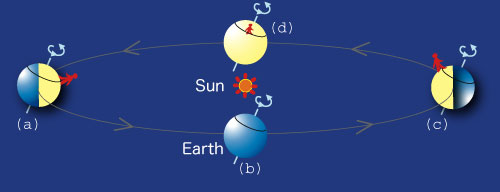
Let's start from position (a).
To make it easier to understand the motion of objects in our skies, depicting the heavens as a sphere surrounding the earth; "The Celestial Sphere" is helpful. The Celestial Sphere
Every object we see in space is drawn on the Celestial Sphere. The sun is also one of them, so you can draw it on it. The picture below shows the sun and the earth at position (a). The plane in which the earth revolves around the sun (= orbital plane) is tilted at approximately 23.4 degrees to the earth's rotation plane. So, the sun in the position (a) can be drawn at 66.6 degrees from the earth's axis on the Celestial Sphere as the next figure.
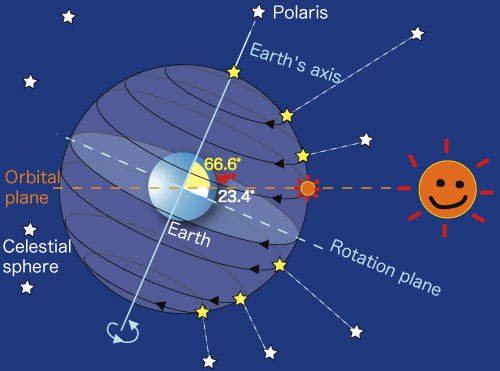
Next, make the earth small in the centre of the Celestial Sphere, draw the ground for the observer and draw the path of the motion of the sun. It will be as shown in the next figure.

Remember that the direction where Polaris is is north and where the sun rises is east, write each direction in.
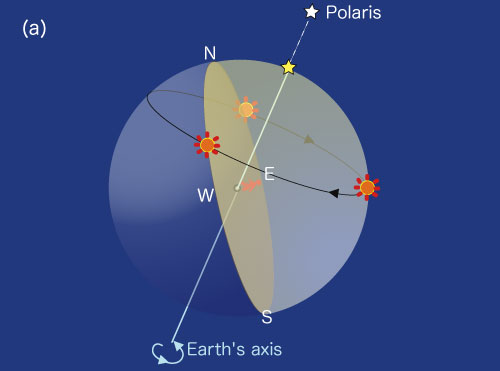
How about position (b)? In the (b), the underside of the screen is daytime, so you can not see the observer who is also on the underside. Then, the figure will represent the view from the earth's surface. Because the direction the sun rises is east, each direction will be as shown in the next figure.
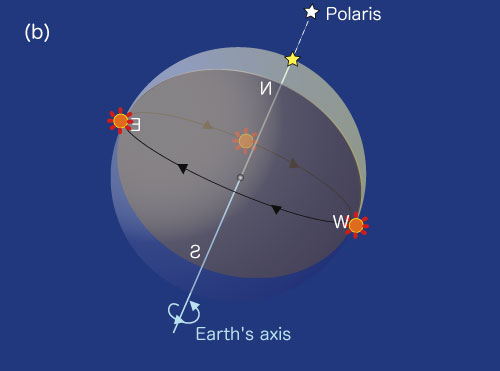
In the same way, think about the path of the sun in the position (c) and (d).
Here is the path of the sun in the position (c).
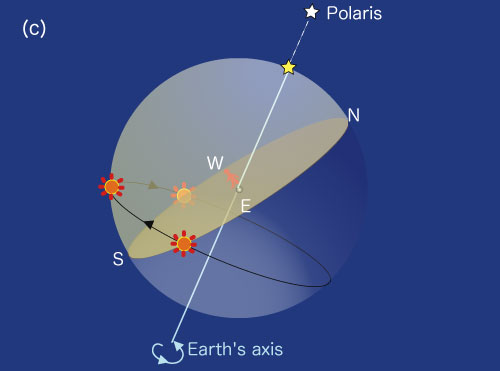
Here is the path of the sun in the position (d).
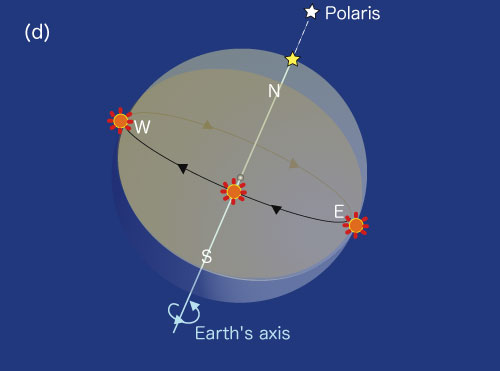
天球で確かめよう(2)
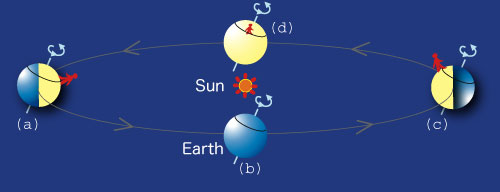 |
|
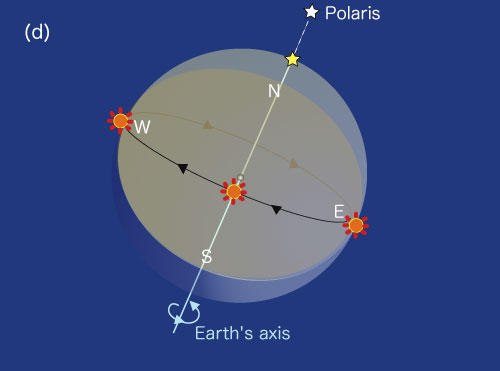 |
|
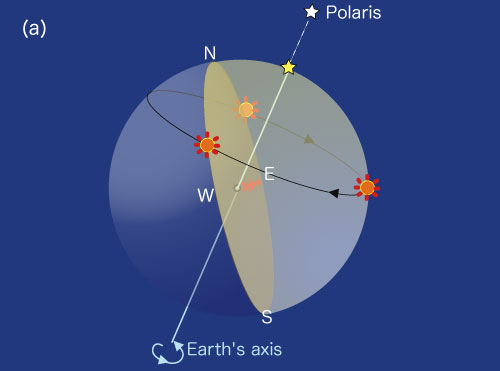 |
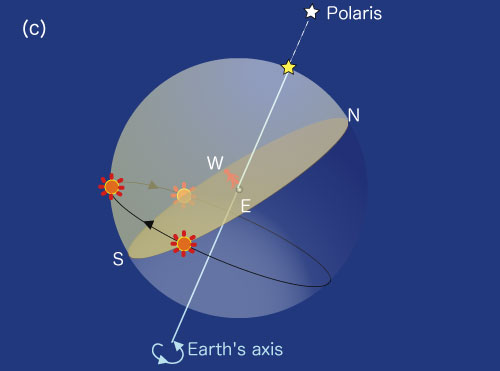 |
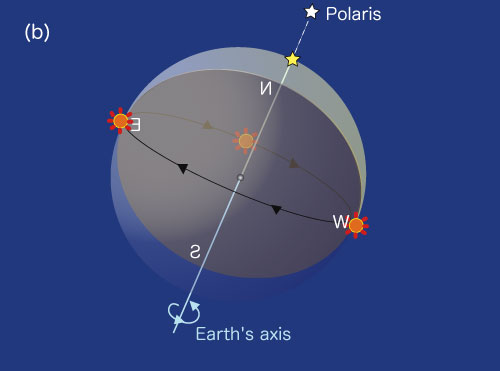 |
|
Here, draw those paths of the sun on a Celestial Sphere which is tilted to make the observer stand vertical. Be aware of the direction.
It will be as in the next figure.
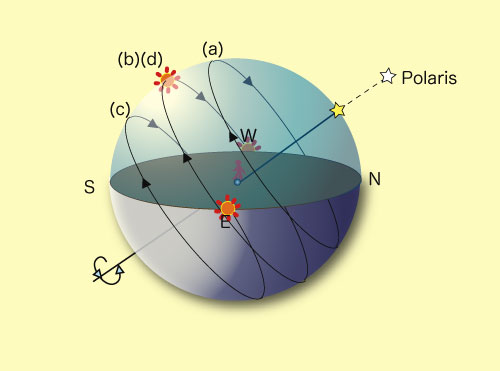
Understanding the Celestial Sphere(3)
How about the seasons of the Northern Hemisphere in each position (a), (b), (c) and (d).
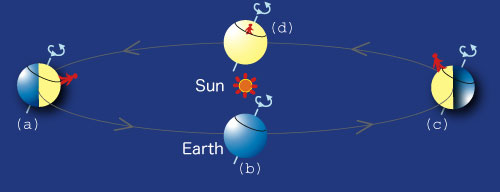
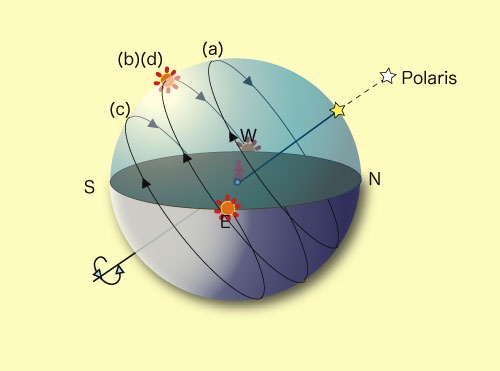
Describe the length of day and night and the Culmination altitude comparing position (a), (b), (c) and (d).
| Position of the Sun and the Earth | Day and Night | Culmination ALtitude | Season of the Northern Hemisphere |
| (a) | Day is longer. | Highest | Summer Solstice |
| (b)(d) | Day is longer. | Medium | Autumnal/ Vernal Equinox |
| (c) | Night is longer. | Lowest | Winter Solstice |
Understanding the Celestial Sphere(4)
If the earth's axis were vertical to the orbital plane, what would the path of the sun on a Celestial Sphere be?
The orbital motion of the earth and the path of the sun in the position (a), (b), (c) and (d) would be as the next figures.
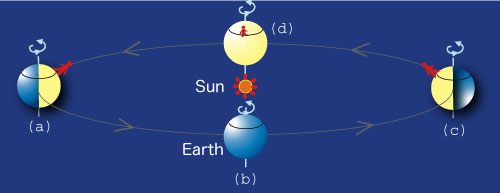 |
|
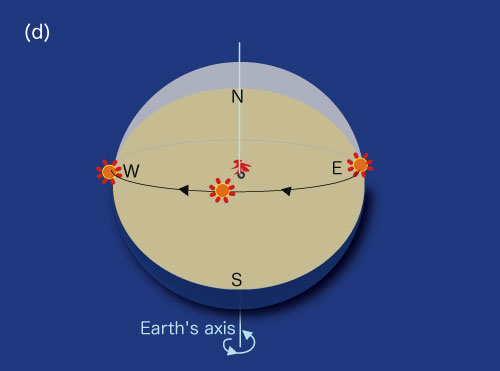 |
|
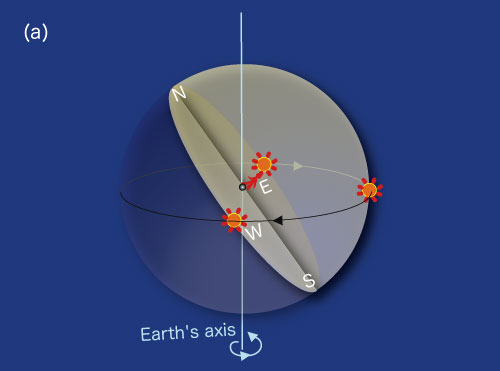 |
 |
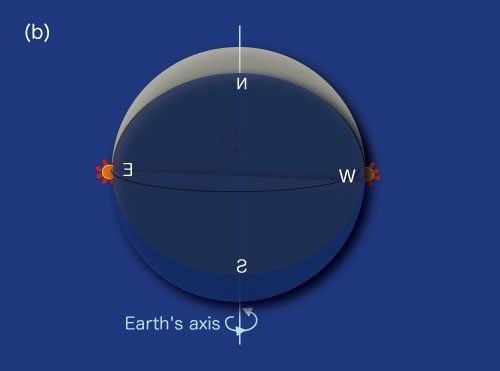 |
|
Draw those paths of the sun on the Celestial Sphere which is tilted to make the observer stand vertical. Be aware of the direction.
It will be as in the next figure.
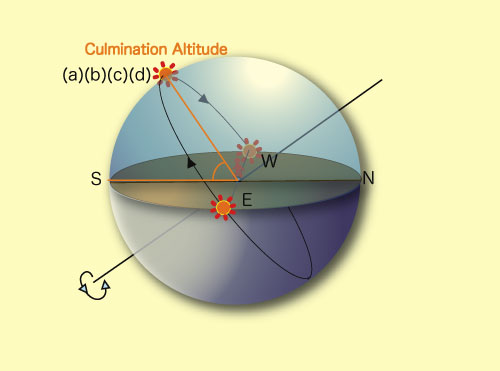
The path of the sun in the position (a), in (b) or (d) and in the (c) are all different when the earth's axis is tilted. However, if the earth's axis weren't tilted, the path of the sun would always be the same in any position and there would be no difference in the length of day or the culmination altitude.
Thus, the tilt of the earth's axis is the reason for the seasons.
Challenge
Uranus' axis is tilted at approximately 90 degrees to the orbital plane. This tipped rotational axis gives rise to extreme seasons on Uranus. In summer, 21 years of daytime in the Northern Hemisphere and in winter, 21 years of nighttime. Think about which position, (a), (b), (c) or (d) shows summer or winter for Uranus.














